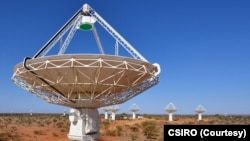New data from a sophisticated radio telescope in South Africa is helping scientists uncover the secret of one of astronomy’s newest mystery objects — faint rings of radio waves called “Odd Radio Circles.” ORCs were first revealed by Australia’s national science agency.
In 2019, experts at Australia’s Commonwealth Scientific and Industrial Research Organization, or the CSIRO, discovered “spooky glowing rings in the sky” using a powerful radio telescope in Western Australia.
They were unlike anything they had seen before, and they were called ‘odd radio circles', or ORCs.
They are rare, faint rings of radio emissions that surround a galaxy with a highly active black hole at its center. Experts believe they are about a billion light years away from Earth.
Their origin continues to puzzle scientists, but fresh information has been provided by new detailed images captured by the South African Radio Astronomy Observatory’s “MeerKAT” radio telescope.
They have allowed researchers to peer “deep inside the heart of the ORCs.”
There are now three main theories to explain what causes them. Scientists believe they could be the remnant of a huge explosion at the center of their host galaxy, powerful jets of energetic particles “spewing out” of the galaxy’s center, or the “result of a starburst ‘termination shock’ from the production of stars in the galaxy.”
Professor Ray Norris is from Western Sydney University and is affiliated with the CSIRO. He is an authority on ORCs and says research into deep space has practical applications.
“The thing about basic science is you never know what is going to come out of it just like with these ORCs. We do not know what is going to come out of it. But we are likely to uncover new physics. You know, when people first discovered radio waves, they really thought there was no practical application whatsoever and yet now we have Wi-Fi and TV and everything else. But if you are looking towards the long-term advance of human knowledge, human science, human technology, this is absolutely what you have to be doing ... is studying how the universe works, finding out what else is out there that we do not know about.”
The research is published in Monthly Notices of the Royal Astronomical Society.
New Images Help Scientists Unlock Secret of Deep Space Mystery
- By Phil Mercer

SYDNEY, AUSTRALIA —



